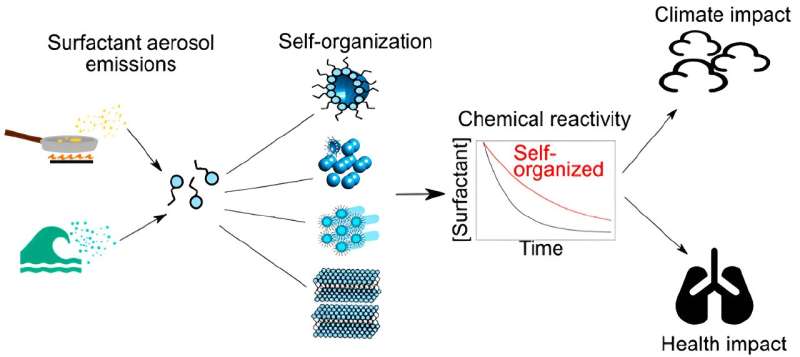This article has been reviewed according to Science X's editorial process and policies. Editors have highlighted the following attributes while ensuring the content's credibility:
fact-checked
peer-reviewed publication
trusted source
proofread
Surfactants can cause toxic chemicals in aerosols to last longer in the air

Research led by the University of Birmingham has found that hazardous chemicals commonly encountered in aerosols, such as those produced by cooking and cleaning, can be "protected" in 3D structures formed by surfactants, causing them to last longer in the air.
Surfactants, or "surface-active agents" are a class of chemical compounds that are used in everyday objects such as soaps and cleaning products, as emulsifiers, foaming and wetting agents. They are also released through natural processes such as sea spray and a key emission from cooking activities.
The research, published in Accounts of Chemical Research, was led by the University of Birmingham in collaboration with the University of Bath and the Central Laser Facility at the Science and Technology Facilities Council.
The scientists have built an extensive body of research over the last 5–6 years initially examining how one of these surfactants, oleic acid, a common cooking and marine emission, forms complex structures at the nanoscale, and how these affect the interaction of oleic acid with other chemicals in the air. Recent experiments explored increasingly complex mixtures of surfactants to establish the impact of a broad range of aerosol components encountered in the air.
Professor Christian Pfrang from the University of Birmingham who led the work said, "Aerosols are commonly created by everyday activities such as cooking and cleaning, and with modern life seeing people spending on average 90% of their time indoors there is an urgent need to understand how indoor aerosols are processed. Oleic acid is known to self-organize into a range of 3D nanostructures, some of which are highly viscous and can delay the aging and thus the breakdown of key chemical components in aerosols."
By combining laboratory and computational studies the researchers established that harmful, reactive materials may be shielded inside aerosol particles and underneath highly viscous (honey-like) shells, potentially extending the atmospheric residence times and thus their reach from the emission source of the otherwise short-lived species.
The researchers conducted a wide range of experimental studies investigating self-organization in particles levitating in the air as well as in thin films on solid surfaces ("window grime" proxies) and floating on water (representing the surface of aqueous droplets which are most commonly found in the atmosphere).
These self-organized aerosols were analyzed with state-of-the-art techniques, following the structure on the nanoscale with small-angle X-ray scattering and the chemical behavior with Raman microscopy. Complementary computer models were developed by the team to understand how surfactants may organize themselves in the atmosphere.
They found that surfactants can organize themselves into different kinds of 3D structures when mixed with other aerosol components found in the atmosphere. This self-organization significantly reduces the reactivity of the chemicals, in turn increasing their lifetime. A crust of product material may form on the surface of the particles, protecting hazardous materials and extending the time they may persist in the atmosphere.
Prof. Pfrang continued, "Our complex multi-scale experimental studies intimately linked to tailored computational modeling indicate that these surfactant structures may offer an effective shield for harmful chemicals common in aerosols which could persist in the atmosphere for longer and travel much further."
"For those of us who spend the vast majority of our time indoors, which is most people in the Western world, this should be cause for concern. We know that aerosols contribute to air pollution and can have a negative impact on human health, and these findings indicate that we are breathing in more harmful chemicals for longer than we have previously thought, especially after cooking and cleaning."
The research has opened avenues to further study how these surfactant arrangements impact the climate as well as both indoor and outdoor air quality.
Prof. Pfrang concluded, "The crucial question now is, how important are these processes that we have carefully quantified in the laboratory in real-life conditions—indeed, we have started to collect aerosol samples for analysis from areas where high concentrations of surfactants are to be expected, such as students' kitchens."
"More research is needed to understand how these structures act both outdoors and indoors, what this means for the quality of the air we breathe, and the impact this may have on human health. But in the meantime, we would recommend opening a window and making sure your space is well ventilated while cooking and cleaning."
More information: Adam Milsom et al, Molecular Self-Organization in Surfactant Atmospheric Aerosol Proxies, Accounts of Chemical Research (2023). DOI: 10.1021/acs.accounts.3c00194
Journal information: Accounts of Chemical Research
Provided by University of Birmingham



















